If you’ve seen the trailer and publicity for the upcoming Tom Hanks/Julia Roberts movie Larry Crowne, then surely you’ve noticed its usage of that over-used movie trope, “once ridiculed mode of transportation becomes celebrated by characters.”
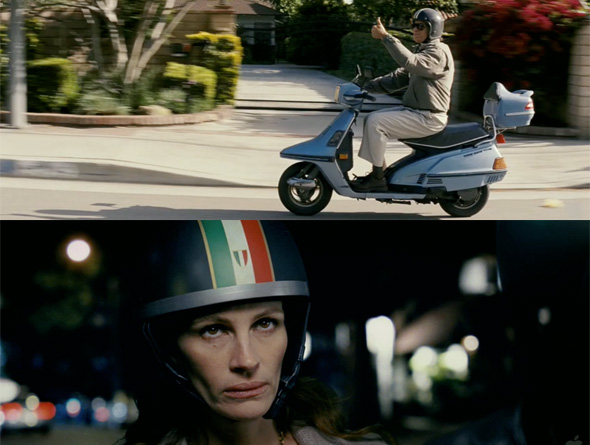
C'mon, Julia. Take that frown...
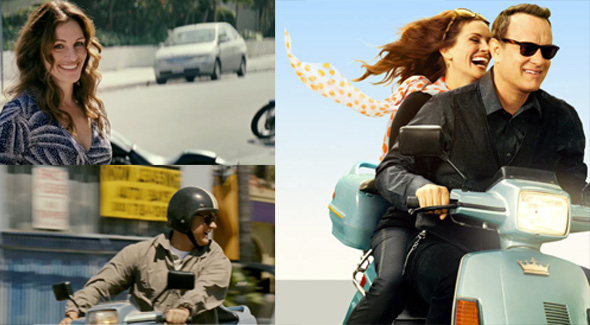
...and turn it upside down.
What’s that? You’re not familiar with this over-used trope? Well, that’s because it’s not over-used at all. In fact, when it come to depictions of transportation in movies, it’s far more common to see characters swapping a ridiculed mode of transportation for a sexier one rather than changing their attitudes to the same mode of transportation.
The reason for this is somewhat obvious; having characters change from bike/speeder/plane to a car/Millenium Falcon/train is an effective tool for filmmakers to highlight changes to characters and their circumstances. Having characters change from disliking a scooter to liking a scooter is a bit more complicated and requires other, less visual things like relationships, maturity, and confidence, to change.
But maybe something else is going on here. Maybe the disparity is indicative of this particular moment in American transportation policy.
Let’s start our journey by examining the more straightforward of our two transportation tropes: characters upgrading their mode of transportation.
There are countless examples of this, so I’ll stick to pointing out two highly illustrative instances. In the Karate Kid, Daniel starts the movie as an impotent, humiliated teenager. Not only do the Cobra Kai bullies kick the crap out of him, they also zoom around on their intimidating motorcycles while Daniel putters around on his bicycle.
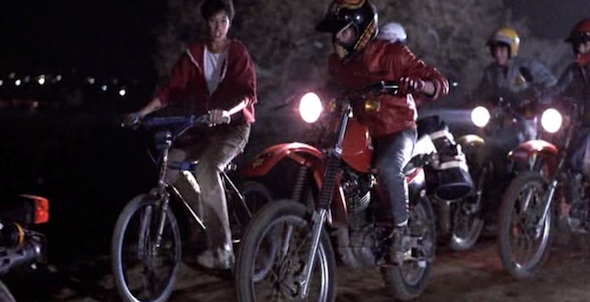
Sweep the bike, Johnny!
Mr. Miyagi remedies both of these problems by teaching Daniel karate and hooking him up with a sleek convertible.
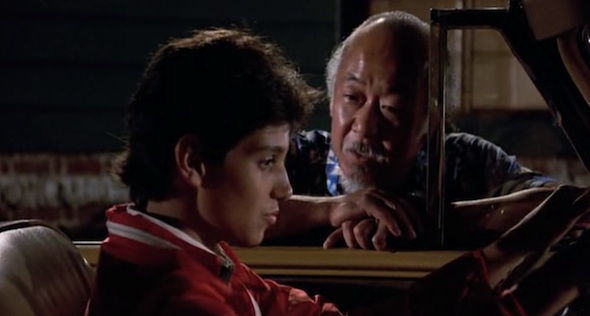
Daniel-san presumably gets to second base in this car with Elisabeth Shue.
In Avatar, the paralyzed Jake Sully trades his wheelchair for a Pandoran Direhorse while in Na’vi form, and as both his skills in his new body and his affinity for the Na’vi increase, he acquires a flying Mountain Banshee on his way to taming the mighty Toruk.

I SEE YOU. Remember back in early 2010, when that reference was hi-larious?
In both of these instances, the filmmakers chose to give their characters’ progress a concrete, visual representation rather than just let it be stated in the dialog or inferred from actions. Some might call it lazy or leaning on a crutch, but it undeniably works. Often, these new vehicles are required by the plot; the hero needs the car/Toruk in order to get the girl/defeat the Sky People.

Awww, yeah.
But more importantly, this technique is rooted firmly in one of the most important rites of passage in American culture: learning how to drive and getting a driver’s license. The feeling of progress that a teenager gets when s/he achieves this sort of independence of movement is huge, and that’s clearly what filmmakers are taping into when giving characters new wheels or wings.
I could go on with more examples–the aforementioned Star Wars (Luke trades his speeder for the Millenium Falcon and eventually an X-Wing fighter), X-Men: First Class (mutants putter around in cars until they catch a ride in Beast’s SR-71)–but you get the idea. As characters progress, so too should their method of transportation.
But what happens when characters are presented with an undesirable mode of transportation and, instead of upgrading to a new mode, simply change their attitudes towards it? The same thing as in the above trope: the character’s attitude has changed because, well the character has changed. Only in this instance, the character’s growth is shown not by acquiring a powerful new vehicle, but by learning to accept a modest method of getting around.

Awww...yeah?
In The 40 Year Old Virgin, Steve Carrell’s character is ridiculed for riding a bike, and it’s often portrayed as one of the many things keeping him from getting laid. But by the end, he doesn’t get the girl with a hulking sports car; instead, the Catherine Keener character joins him for bike rides, goofy helmet and all.
And from what I can tell of the Larry Crowne trailer and marketing materials, the Julia Roberts character goes from regarding Tom Hanks’s scooter with disdain to riding along with joy.
These are the only two examples of this trope that I could come up with, but even if there are others out there, I’m pretty sure that they would also be romantic comedies. These movies, unlike their action counterparts, are mostly about people changing and growing together, not about one hero achieving self-actualization. The former lends itself to characters adapting to someone’s quirky mode of transportation; the latter lends itself to characters achieving Ultimate Power with the help of Fast Cars and Planes That Blow Things Up.
But why is it that, even in the genre that best lends itself to this plot device, is it used so infrequently?
Because Americans have a difficult time dealing with complicated and changing transportation policy issues.
The 40 Year Old Virgin and Larry Crowne present non-car personal transportation modes as positive choices in contrast to the dominant cultural attitude that these things are second-rate compared to cars. Outside of movies, challenging that notion is a relatively new phenomenon. The “livable streets movement” that criticizes auto-centric transportation policies is a fairly recent phenomenon in America. In 2006, one year after the release of The 40 Year Old Virgin, the website Streetsblog.org writes:
When we started, the mayor [of New York City] could still be heard in public saying that more traffic was good for the city. Improving streets for people who walk, bike, and ride the bus was not a top priority.
…
Our coverage amplified the message of transportation advocacy organizations and provided a unique counterweight to media coverage biased in favor of the car-centric status quo.
(Emphasis is mine.)

Ah, the freedom of movement afforded by the automobile.
Urban planners and advocates were finally getting wise to the fact that suburban sprawl and traffic-choked roads were unfortunate by-products of our automobile dependent culture and infrastructure. But as the movement gathered steam in the last half of the decade, so too did controversy over transportation policies that didn’t prioritize cars first.
In 2008, a proposal to levy a toll on cars entering Manhattan during peak hours (congestion pricing) set of furious debate in New York City and ultimately failed to gain passage in the New York State Assembly. In the first years of the Obama administration, a proposed national high speed rail network was criticized as “socialist” by the same politicians who preferred to funnel billions of dollars into highway and road projects. And in the last years of Michael Bloomberg’s mayorship of New York, his transportation secretary’s ambitious projects to slow down traffic and build bike lanes in New York have been met with protests and lawsuits.
In other words, Americans are slow to accept the counter-intuitive truth that they are trapped by their automobiles, the vaunted symbol of American independence and freedom of movement. Rising gas prices have chipped away at this reluctance, but not to the point where adults are commonly presented as choosing bikes, scooters, or public transportation instead of cars in movies and TV.
Not yet, that is. Maybe Larry Crowne is at a tipping point in our national discourse on cars; it could be both a reflection of our past attitudes towards non-car transportation options (lame, sucks compared to cars) as well as a preview of our future attitudes on such options (OK, a viable option compared to cars).
Take a look at this publicity art from the Larry Crowne website:

Get on your bikes and ride!
Notice that it’s not just Tom and Julia on the scooter; they’re trailed by a whole gang of scooter-riders. As if they’re blazing a trail towards America’s transportation future.
Before I close, I should acknowledge a couple counterarguments to what I’ve presented above: 1) scooters are not the same thing as bicycles and 2) motorcycles, close cousins to scooters, have long been presented as non-shameful alternatives to cars in movies. To counter that, though, I would say that 1) scooters don’t offer nearly as much potential mobility as cars in that scooters don’t have the range or the speed of a car and 2) motorcycles are more comparable to cars in that regard. More importantly, scooters, like bikes, are enduring symbols of urban, car-less commuting.
I should also acknowledge that I’m not necessarily criticizing movies that show a hero obtaining a powerful vehicle as a visual depiction of his/her self-actualization. But if that vehicle has poor gas mileage, and if the roads are clogged with traffic, then our hero might be better off on a hipster fixie bike or a Eurotrash Vespa instead of a car.
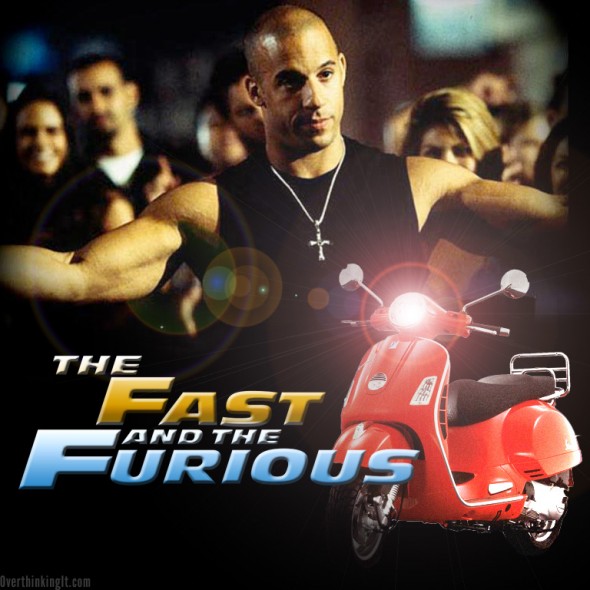
As a planner-cyclist with a motorcycle endorsement, I have to say – great post!
I would add one in the bromance category. Jason Segel’s character in “I Love You Man” rides around on a Vespa, even taking Paul Rudd for a ride during one of their man dates. It’s a punchline, no doubt about it, but I think it’s also a sign of supreme self-confidence. In this case it’s the audience that changes to embrace the scooter, especially when ridden with great haste by a six-footer in a tuxedo.
Segel rides a Vespa in real life, to TMZ’s delight.
Side note: I have long aspired to make a Euro-smooth-jazz cover of “Born to be Wild” called “Born to be Mild” to be played in a cafe that the Vespa is parked outside of while you sip on espresso.
Small quibble–Elizabeth Banks *is* in the 40 Year Old Virgin, but her character is kind of a scary, sex fiend played out for gross out laughs. Catherine Keener is the real love interest.
Also, what’s interesting is that Julia Roberts and Catherine Keener are both women older than 40. I wonder what it says about them having to “downgrade” from expectations of winning a man with a car (which like it or not, is a symbol of virility and monetary cache in a man) to happily accepting their dorks on two wheels.
Re: Elisabeth Banks/Catherine Keener, thanks for catching that. Corrected in the post.
Re: women older than 40, I think you’re on to something. If I recall correctly, the concept of women “settling” for a less-than-ideal guy instead of holding out for Mr. Right was circulating through the zeitgeist a few years ago. Does this sound familiar to anyone else?
Lori Gottleib’s case for settling: http://www.theatlantic.com/magazine/archive/2008/03/marry-him/6651/
I honestly can’t bring myself to read the whole thing. It’s basically one sad woman trying to come to grips with the fact that she’s afraid of dying alone and tired of being a single mom and she’s trying to project her own insecurities onto women as an entire group. I won’t deny that marriage is a bigger issue for women than men, but I blame that only partly on biology. I think societal pressure on women is what creates most of the “why aren’t I married yet??” paranoia.
For all the people that think they’re too cool for scooters, or live in rural areas, Boston Dynamics should mass produce the mechanical steed “Big Dog” http://www.youtube.com/watch?v=W1czBcnX1Ww
Imagine all the aholes on robotic clydesdales rearing up on titanium hind legs giving the universal sign of challenge to nerds on vespas to a race, tortoise and the hare morality play ensues, all learn the value of friendship, our differences are our strengths, lightsabers are to be respected and are not toys, robot hands aren’t better than real hands.
That’s the future I want for my children, the future we were all promised in the 80’s but never got, hover-boards my ass -vespas!? that’s all we got! 2011=Vespas!? Talk about downgrading expectations, at least Larry Crowne isn’t over-promising I guess.
how about this car-bike for 2010s http://www.youtube.com/watch?v=0iHTaoXW4TA
Yeah that’s cool, 3 wheels enclosed cab, right on. I live near Seattle and it rains every. freaking. goddang. day. scooters are impractical. One diehard in my town commutes everyday geared up like an Arctic crab fisherman to keep dry.
To future up a replacement for enclosed cabs I was gonna suggest a laser shield that shoots down rain drops like they have for mosquitoes http://youtu.be/BKm8FolQ7jw but that would have roads full of steam, then some smart ass kid who cranks his lasers to 11 and blinds people who aren’t already blinded by steam, it’d be a mad max hippie rave holocaust. Of course if I owned a laser manufacturing company this would still be the plan I’d lobby ruthlessly for.
don’t forget Clueless: “Why should I listen to you? You’re a virgin who can’t drive”
Cher owned a Jeep Wrangler already though. She was just really bad at driving it.
I spent some time in Indonesia a few years ago. It’s a poor country, where most people do not have the income level required to purchase a car. But scooters and motorcycles are more easily obtainable. So instead of the streets being clogged with cars, they’re clogged with scooters. And of course everyone’s seen pictures of bicyclists packed into Chinese streets like sardines. Point being that traffic and sprawl and danger are products of urbanization and readily available transportation – you can’t blame everything on the car.
Yeah but scooters use less gas while sitting in traffic or something so that’s kind of a start towards everything in walking distance towns that barley use cars, in a way.
On danger, early 90’s in a world where SUV’s are getting popular there was this report on the news, 60 minutes I think, showing crash tests of a car and get t-boned by an SUV saying it was like exactly 53 million times worse than a car, report ends, commercial for SUV comes on. The whole point was to think if you didn’t have an SUV you’d die, it obviously worked. The Simpson’s Canyonero ad in German just to spice it up, http://www.youtube.com/watch?v=I6qpQzK2Rj4&feature=related
It’s similar with scooters, only the planet will die, but I wonder how advertisers are gonna twist that around and make scooters seem safe for roads? Now that most people drive SUVs out of fear of being the smaller fish how do you get the smallest fish of all to be the most popular? Avoid the safety issue like the plague? But I have nothing to back that up, I have no idea how safe scooters are.
Scooters are probably reasonably safe – more dangerous than a bicycle, but less dangerous than a motorcycle. There are probably very few speed-demons or road-ragers on scooters, just by the nature of the vehicle. But in Indonesia, I routinely saw families of three or four (sometimes including an infant) piled onto a single scooter, which multiplies the danger factor like 80 times.
I figure it’s similar in Brooklyn, but in LA I always feel as if I’m risking death when I ride my bike. I still ride it, but only short distances and if I don’t need to transport anything. I wish more people would bike but bike lanes are pretty pathetic here and drivers really don’t look for bikes.
The Sex and the City episode where Carrie had to take the bus falls into the downgrading your transportation trope, kind of. I don’t think Carrie ever accepted the bus and it’s odd to imagine a new yorker who had never rode the bus but was in her 30s. I don’t think you ever see any of the girls on the subway either.
I’m not satisfied with the narrative that this trope is purely the result of filmic convenience. I am partially satisfied to be sure, having a dramatic external change can be used as short hand for representing dramatic internal change. However, in the last Clichemaggedon, I suggested: include an experience where the main character purchases and is satisfied with a commercial product as staple Cinema Americana. This grows out of an internalized vision of self as an autonomous individual and of industry’s ability to equip them with the trinkets of a hero’s journey.
Americans tend to mythologize the origins of their possessions in a different way than other cultures. Of course most all character arc’s I’ve ever seen will start with the hero having some undesirable possessions and end with them holding something quite better. Where these things come from and how they reflect upon their user are usually a different story.
Americans tend to have a John Wayne approach to fire arms. While the obvious implication of that sentence is to make a charicature romanticizing the ol’ west, I actually mean to take it on a bit of a detour. John Wayne’s physic would be generously described as “portly” and while I will immediate concede the point that body image within the John Wayne era of film was much closer to reality than say today’s, I still have a difficult time imagining John Wayne as a particularly powerful man with his body. This is reflected in the emphasis of many of his films in which its almost never the point to display what he can do physically with his own bodily effort. John Wayne is the hero by the wit of his gumption and his skill with a gun.
For John Wayne, power flows from the barrel of a gun. This has a whole lot to do with America’s own warrior culture aging in the era of the gun, but also of how these weapons are used against the enemies of our times. John Wayne and the gun are separate entities, there is no mutual spirit between them. John Wayne is not the gun and the gun is not John Wayne. John Wayne uses the gun as a means to combat other people or other places or other ideas. It is not an extension of the self but an enterprising means to exert one’s will onto the environment. Rarely do you ever see a western where people name their guns, go on and on about what kind of steel they were made from, or have the film end with a main character being killed by their own beloved weapon. Indeed in both the Cohen Brothers remake and the original film, the young girl – Matty Ross, laments that her gun was not made fine enough to kill Tom Cheney. Had she the mind for guns she would have purchased a better one, one less likely to misfire.
American mythologies of commerce tend to separate the user from the product. These are sometimes conflated as with the case of Steve Carrel and his dorky scooter, but again, modifying the subjective qualities of inanimate objects is something of an exception, as noted here. It is much more in keeping with the spirit of American industry to go along with that brave new world quote, “Ending is better than mending”. Films would much rather have their characters throw something in a trash heap and buy something altogether new that learn to love what they got.
Great article. A few other conventions relevant to vehicles and self-actualization:
-Getting a faster, bigger or better armed and armored vehicle, not for self-actualization, but for survival. This is common in disaster/apocalypse movies, whether natural or zombie. The act structure of that sad 2012 John Cusack movie is dependent on what vehicle they need to keep surviving and with whom – limousine -> little plane -> big plane -> apocalypse-survival vehicle. The characters are no more self-actualized with each new vehicle- no more in control than they were before- they are merely surviving one way or the other, and furthermore, they are becoming more and more reliant on other people to do so. Noah’s ark or that other Steve Carell movie, Evan Almighty, might be interesting to consider in relation to your article as well as survival.
-Losing or giving up a vehicle as growth and self-actualization. Luke’s ultimate test was on foot and could not have been faced in a vehicle. This is related to a Buddhist metaphor: you can cross the river by building a boat but once across and faced with a mountain to climb leave the boat behind. Carrying it will only hold you back.
-The Avatar example can go another way. The series of mounts are not merely means of greater self-actualization but also an expression of greater interpenetration or co-actualization, a major theme of the movie. I admit that as portrayed the method of riding the mounts was one of mastery and control – rider thinks and mount does, but in theory it was more bidirectional.
-Vehicle as community in road trip movies and the Millennium Falcon. People get out of the car when they are self-actualizing. Getting back in the car is an affirmation of being part of the group, accepting your dependence on them and a certain humility- albeit often begrudging.
You, my friend, are not over thinking anything. What is this?
One point about scooters is that they’re often used to symbolize “cool but not macho” – culturally, they’re basically feminine motorcycles. Someone shown as riding a scooter is more likely to be shown, similarly to the biker, as someone who is too cool for something as ordinary as a mere car. Anyone can have a car. Only a quirky awesome person gets a scooter.
But the reason it’s a laugh line is something like I Love You Man is that it’s coded as a “girl vehicle”, and the curves on a Vespa (like those of the revived VW Beetle, with it’s 90% female ownership rates) only accentuate their perceived femininity.
(That’s putting aside something like the way Haruko’s physics-defying Vespa from FLCL is used as an extension of her violently sexual alien nuttiness.)
Incidentally, I’d also say the polar opposite of the scooter is not the car or the suburban SUV, but the pickup truck – which symbolizes not only masculinity, but more specifically hard manual labor, which is to say virtuous, working-class masculinity – as opposed to the scooter’s femininity and (as noted above) hipster urbanity. It should also be noted that the largest-selling vehicle in the United States has for many years been, and still is, the Ford F150.